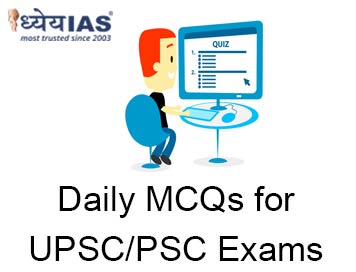Home > Daily-mcqs
Daily-mcqs 07 Nov 2025

Q1:
With reference to the newly discovered spider species Pilia malenadu, consider the following statements: 1. Pilia malenadu belongs to the genus of orb-weaver spiders (family Araneidae). 2. It was discovered in the foothills of the Western Ghats in Karnataka. 3. The species was found exclusively on two plants—Memecylon umbellatum and Memecylon malabaricum. Which of the statements given above is/are correct?
A: 1 and 2 only
B: 2 only
C: 2 and 3 only
D: 1, 2, and 3
Answer: C
Explanation:
Statement 1 – Incorrect:
Pilia malenadu belongs to the genus Pilia, which is a genus of jumping spiders (family Salticidae), not orb-weaver spiders (family Araneidae).
Statement 2 – Correct:
The spider was discovered in Madhugundi village, Mudigere taluk, Chikkamagaluru district, in the foothills of the Western Ghats of Karnataka.
Statement 3 – Correct:
The species was found exclusively on two plants—Memecylon umbellatum and Memecylon malabaricum—indicating a specific microhabitat preference.
Q2:
Consider the following statements regarding India–Israel defence relations: 1. According to SIPRI (2020–2024), Israel was India’s third-largest arms supplier after Russia and the United States. 2. The two countries jointly developed the Barak 8 missile system and the Drishti-10 Starliner drone. 3. India and Israel participates military exercises such as “Blue Flag,” which includes aerial combat training. Which of the statements given above is/are correct?
A: 1 and 2 only
B: 1 and 3 only
C: 2 and 3 only
D: 1, 2, and 3
Answer: C
Explanation:
Statement 1 – Incorrect:
As per Stockholm International Peace Research Institute (SIPRI) data for 2020–2024, Israel was India’s third-largest arms supplier after Russia and France, not the United States.
Statement 2 – Correct:
India and Israel have jointly developed Barak 8, a surface-to-air missile system, and Drishti-10 Starliner, an Indian variant of Israel’s Hermes-900 UAV.
Statement 3 – Correct:
The two nations conduct joint training exercises such as “Blue Flag” (a multinational aerial combat drill) and also collaborate in counter-terrorism training for India’s National Security Guard (NSG).
Q3:
With reference to CITES technical mission, consider the following statements: 1. The CITES technical mission to India was conducted to verify wildlife imports to facilities in Vantara initiative in Gujarat. 2. The report found that all imported animals lacked CITES permits. 3. The mission recommended that India strengthen due diligence in verifying the true origin and legality of imported wildlife species. Which of the statements given above is/are correct?
A: 1 and 2 only
B: 1 and 3 only
C: 2 and 3 only
D: 1, 2, and 3
Answer: B
Explanation:
Statement 1 – Correct:
The CITES mission visited India from 15–20 September 2025 to inspect the Greens Zoological Rescue and Rehabilitation Centre (GZRRC) and the Radha Krishna Temple Elephant Welfare Trust (RKTEWT) — both part of the Vantara initiative in Jamnagar, Gujarat.
Statement 2 – Incorrect:
The report did not claim that the imported animals lacked CITES permits; in fact, it stated that all imports had valid CITES permits, but raised doubts about the accuracy of the source codes (e.g., some animals possibly being wild-caught but labelled as captive-bred).
Statement 3 – Correct:
One of the key recommendations was for India to strengthen due diligence and verify the true origin and legality of wildlife imports, even when CITES permits are issued.
Q4:
Consider the following statements regarding the Convention on International Trade in Endangered Species of Wild Fauna and Flora (CITES): 1. CITES was adopted in 1973 and came into force in 1975. 2. It classifies species into Appendices I, II, and III based on the level of trade regulation required. 3. India is not a party to CITES but follows its guidelines under the Wildlife Protection Act, 1972. Which of the statements given above is/are correct?
A: 1 and 2 only
B: 2 only
C: 1 and 3 only
D: 1, 2, and 3
Answer: A
Explanation:
Statement 1 – Correct:
The CITES treaty was adopted in 1973 and came into force in 1975 to regulate international trade in endangered species.
Statement 2 – Correct:
CITES includes three appendices:
Appendix I: Species threatened with extinction — trade permitted only in exceptional cases.
Appendix II: Species not necessarily threatened with extinction but trade must be controlled.
Appendix III: Species protected in at least one country that has asked other CITES parties for assistance.
Statement 3 – Incorrect:
India is a party to CITES, having acceded in 1976, and has designated national authorities to issue import/export permits.
Q5:
With reference to the frequent earthquakes in Afghanistan, consider the following statements: 1. Afghanistan lies at the convergence of the Indian, Arabian, and Eurasian tectonic plates. 2. The Chaman Fault, a major strike-slip fault, contributes significantly to the country’s seismic activity. 3. Afghanistan is located within the Circum-Pacific Belt, the most earthquake-prone region in the world. Which of the statements given above is/are correct?
A: 1 and 2 only
B: 2 only
C: 2 and 3 only
D: 1, 2, and 3
Answer: A
Explanation:
Statement 1 – Correct:
Afghanistan’s frequent earthquakes occur because it sits where three major tectonic plates meet — the Indian Plate, the Eurasian Plate, and the Arabian Plate. These plates collide and slide against one another, creating intense seismic activity.
Statement 2 – Correct:
The Chaman Fault is a transform (strike-slip) fault line located along the Afghanistan–Pakistan border, and it is one of the most active seismic fault systems in the region. It plays a major role in generating earthquakes in southern and eastern Afghanistan.
Statement 3 – Incorrect:
Afghanistan is not part of the Circum-Pacific Belt (Ring of Fire). It lies within the Alpide Belt, the second most seismically active region on Earth after the Ring of Fire.